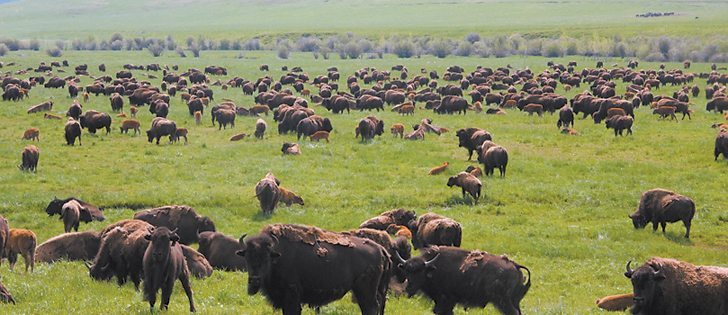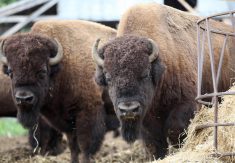NORTH BATTLEFORD, Sask. — Record high bison meat prices have increased optimism in the industry while raising concerns about reduced demand due to cost.
The Canadian bison industry experienced the highest prices ever for meat market animals this past year. Prices have increased from an average of $1.15 per pound hot hanging weight in 2003 to almost $4 in 2011 due to strong consumer demand relative to supply.
Canadian Bison Association executive director Terry Kremeniuk said consumers have resisted prices based on carcass values in excess of $4 per lb.
Strong demand domestically and in the United States and European Union has been the major influence on higher prices.
Read Also

Quebec pork company calls for transparency around gene-edited pigs
Quebec-based pork company duBreton is calling for transparency around meats from gene-edited pigs on concerns that a lack of mandatory labelling will confuse consumers, and dilute certification claims. The organic sector is also calling for labelling rules.
As a result, Kremeniuk keeps an eye on the number of animals slaughtered federally and provincially, which gives him an idea of how many animals are leaving the system.
The number of bison processed in Canada has steadily decreased since a high in 2004-05.
Live bison exports to the U.S. grew rapidly as BSE-related restrictions were removed. A strengthened Canadian dollar and fewer available bison have also contributed to the trend.
“Last year, between federal and provincial slaughter, we’re down to about 12,500 (head),” he told the Saskatchewan Bison Association meeting in North Battleford March 2. “This year, (federal) slaughter numbers are down 30 percent again.”
Kremeniuk also monitors the live bison trade and how many animals are shipped to the U.S. for feeding or slaughter.
Domestic processing has declined since 2008 because of reduced supply and increased exports of live animals to the U.S.
“It was at this point in time that I believe that the herd in North America began to contract,” he said.
The CBA forecasts that domestic slaughter may be down by more than 20 percent from 2010.
The size of the Canadian herd has been steadily declining over the past five years. Based on bison exports and domestic processing, the herd, including the 2011 calf crop, is estimated at 175,000 head, down from 219,000 estimated in 2008.
“Now there’s certainly been a decline because of availability and to some extent the issue is being compounded by the fact that there’s greater heifer retention.”
Kremeniuk said the herd grew by eight percent per year from 1996 to 2006, while producers were selling animals at a rate of 14 percent per year from 2000-08.
“The animals were leaving the herd at a much more rapid rate than the industry was growing and of course something had to give sometime,” he said.
With strong prices has come profitability, which is encouraging producers to expand. Signs of herd rebuilding are reflected by the reduced number of heifers going to slaughter and the number of females offered for breeding purposes.
New capital and new producers are also being attracted to the industry.
“The marketplace is such that there’s going to be a pretty firm price for meat market animals,” Kremeniuk said.
“On the supply side, those people who are tied into the market, they are going to continue to pay the price for the product.… At current prices, a lot of people have pulled away from bison, but now that prices have pulled back a little bit, there’s an interest again. That suggests that maybe the $3.50 to $4 range is the sustainable price range that we’re looking at.”


















